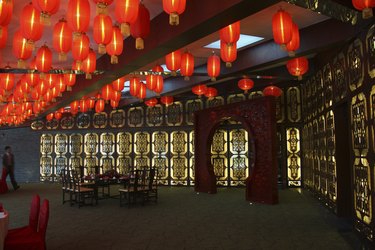
Red, gold-tasseled lanterns abound during the Chinese Lantern Festival -- the day that marks the end of the Chinese New Year, also known as the Spring Festival celebration. It is commemorated on the 15th day of the Chinese calendar's first lunar month. To the Chinese, these lanterns signify reunion, but different lanterns are used on different occasions and ceremonies, all of which have their own meanings.
Chinese Lantern History
Video of the Day
Paper lanterns, first created during the Western Han dynasty, were used as a source of light. The paper cover protected the flame from being extinguished while simultaneously creating a larger and mobile light source. Artisans began decorating the lanterns, adding symbolic motifs to convey mystique. These lantern artists competed each year in the Lantern Festival to create the most striking lantern possible. The most common lanterns are red with golden tassels, often embellished with designs from nature, figures, mythical creatures and animals, insects or birds.
Video of the Day
How They Are Made
Chinese lanterns typically have a bamboo frame, but they can also be made of rattan, wood or wire. Once the frame is constructed, the artisan covers it with silk or rice paper. The artisan then adds his designs or decorations to the lanterns: hand-painted calligraphy or colorful scenes, embroidery, or glued-on paper cutouts.
Color Meanings
Red and gold symbolize wealth, fame and prosperity, or an argument-free marriage, which is why colored lanterns are often used during a wedding celebration. White, opposite to its significance in Western cultures, signifies death, bad luck or failure. The color yellow belongs to royalty,with black symbolizing equality and righteousness and green representing the harmony and balance in nature.
Cultural Significance
Nearly 2,000 years ago, during the Eastern Han dynasty, the lanterns came to symbolize the ascension of Buddha celebrated on the 15th day of the first lunar month, which later morphed to the Chinese Lantern Festival. The emperor, a devout Buddhist, ordered that lanterns be lit on the evening of this day in recognition of Buddha, the golden man's ascension.
Multiple Meanings
As part of the custom of parading the lanterns during the Lantern Festival, parents prepare lanterns that their children carry. As the new school year begins in the first lunar month, the lanterns have come to symbolize a bright year for the child carrying it. Umbrella-type lanterns, hung under a house's eaves or inside the home, indicate prosperity and the family's male members. Palace lanterns signify a wedding or other joyous occasion, while split bamboo lanterns are used to indicate a funeral to the community.
Lanterns and Symbols
Chinese lanterns come in more than one type, including square lanterns, gauze shadeng, palace lanterns, riddle lanterns and more. Dragons -- a Chinese symbol for wisdom, nobility, intelligence strength, prosperity and the power to overcome your enemies -- is a common symbol in Chinese art, on lanterns or feng shui items. Other symbols indicate the harmony and balance in nature, the elements or families. Riddle lanterns hung on the gates outside residences contained a riddle that must be answered for entry.